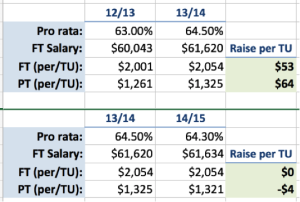Karl Ewald
Introduction
Ultimately, I’d like to propose a strategy for thinking about steady movement toward parity by proposing an “equal raise for equal work” model as a starting point for future discussions. In order to make sense of this proposal, we need to understand the factors that sit within the direct control of CCFT and how they are used to derive the adjunct/overload salary schedule from the contract/regular salary schedule. From there I will discuss a way of comparing salary changes by looking at the relative raise contract/regular and adjunct/overload faculty members will see in their teaching rates. Finally, I will propose a way of using this perspective to provide a starting point for future negotiations cycles.
A Look at Salary Schedules
Despite the complexity of the salary schedules for contract/regular faculty and adjunct/overload faculty (http://devcp19.ccftcabrillo.org/salary-schedules/), there are really only three factors that define the pay relationships between contract/regular and adjunct/overload faculty:
- Pro rata (currently 64.8%)
- Number of TUs per year for a full-time load (currently 30)
- Number of steps in the adjunct/overload schedule (currently 12)
You can compute each square in the adjunct/overload schedule using the equation:
adjunct_overload_pay_per_TU = pro_rata x (contract_regular_salary / 30)
for example, for class 3, step 4 of the current contract:
adjunct_overload_pay_per_TU = 64.8% x ( $62,548 / 30 ) = $1351/TU
If you examine the contract/regular faculty schedule, you will notice that for the different classes (columns), advancement is capped at different steps:
Class 1: 10th step
Class 2: 10th step
Class 3: 10th step
Class 4: 16th step
Class 5: 21st step
Class 6: 26th step
Each square of the adjunct/overload salary schedule is computed as described above up to and including step 12. Class 1, 2, and 3 adjuncts reach cap at step 10 like contract/regular faculty, but adjuncts of class 4, 5, and 6 can not advance beyond the twelfth step.
Examining Contract Changes Through Raise Analysis
In negotiations, the district and CCFT agree to a pool of money to be distributed to faculty salaries. Technically, pro rata must be agreed on in negotiations because it is in the contract. Practically, CCFT determines pro rata as it requires balancing interests of the two member groups of CCFT: adjunct and contract/regular faculty (note that overload units are also paid on the adjunct/overload schedule).
During the last negotiations cycle, I was examining the effect the various pro rata changes by computing the raise each faculty group would see in their per-TU teaching rate. I presented this information at the executive board last spring. While there continues to be discussion around the value of looking at compensation changes in this way, the executive board felt it would be beneficial overall to present this perspective to council as it did influence our decision making on a topic that can be contentious and divisive.
The process is simple enough: Compute the new salary schedules based on the various proposals and from these revised schedules compute the raise each member will see in their compensation. For example, if we examine our most recent compensation changes for class 3, step 4 we see:
For me personally, and perhaps for some of you, this type of analysis provides a sense of equity in dealing with a difficult, inequitable situation. With our current funding situation, we can’t move directly to an “equal pay for equal work” situation, but we can steadily move in that direction through an “equal raise for equal work” perspective. The place where this really breaks down is in the 12-step limit to the adjunct/overload salary schedule.
We can examine the last several years and see how those negotiations cycles appear from the perspective of raises (again, for class 3, step 4):
Moving Toward Parity: A Proposal
Because of the underlying mathematical model, we can adjust the pro rata value to achieve specific outcomes. The proposal here is to start from an “equal raise for equal work” perspective and calculate the associated pro rata value as a starting point for discussions in council.
By “equal raise for equal work” we mean that in terms of gross pay per TU (salary/30) a faculty member would see an equivalent dollar for dollar change in their pay rate regardless of their FT/PT status. In other words, if a full-time faculty member would see an additional $50 per TU then an adjunct faculty member at the same position of the salary schedule would also see an additional $50 per TU in their gross pay. An inevitable consequence of this approach would be a slow and steady movement of pro rata toward parity.
As stated previously, the obvious flaw in this approach is that our senior adjuncts are blocked from following their contract/regular faculty peers beyond step 12. One way to address this would be to negotiate an extra step in the adjunct/overload schedule each year. Again, this wouldn’t be a leap to parity, but would represent a slow and stead move toward parity.
In all cases, council would continue to have the power to recommend ratification or rejection of the contract. As such, council can continue to propose alternate pro rata values based on earmarked funds, state or local priorities, etc. It could also reject or expand adding additional steps to the adjunct/overload schedule. The main utility in this approach would be to define starting point that the majority of council can support and would hopefully increase our sense of unity at a critical time in the negotiations process.










